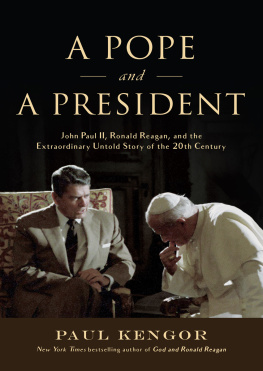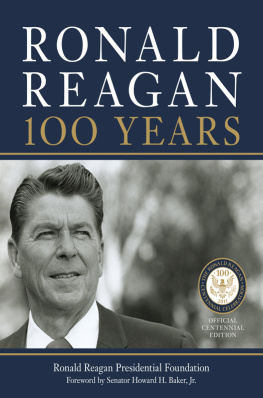
THE DIVINE PLAN
THE DIVINE PLAN
J OHN P AUL II, R ONALD R EAGAN, AND THE D RAMATIC E ND OF THE C OLD W AR
PAUL KENGOR
AND
ROBERT ORLANDO
All rights reserved, including without limitation the right to reproduce this ebook or any portion thereof in any form or by any means, whether electronic or mechanical, now known or hereinafter invented, without the express written permission of the publisher.
Copyright 2019 by Paul Kengor and Robert Orlando
ISBN: 978-1-5040-5889-6
Published by ISI Books
Intercollegiate Studies Institute
3901 Centerville Road
Wilmington, DE 19807-1938
www.isibooks.org
Distributed by Open Road Distribution
180 Maiden Lane
New York, NY 10038
www.openroadmedia.com

Ive always believed that this blessed land was set apart in a special way, that some divine plan placed this great continent here between the two oceans to be found by people from every corner of the Earthpeople who had a special love for freedom.
President Ronald Reagan, January 31, 1983
The only true freedom, the only freedom that can truly satisfy, is the freedom to do what we ought as human beings created by God according to his plan.
Pope John Paul II, September 10, 1987
PROLOGUE
TWO ACTORS IN A DIVINE PLAN
S cene 1: Washington Hilton, March 30, 1981, 2:27 P.M .
President Ronald Reagan has just completed a speech before the AFL-CIO in Washington, D.C.
A crowd gathers outside the hotel to catch a glimpse of the president before he climbs into his motorcade. One young man in the crowd, John Hinckley, has other ideas. The deranged Hinckley has decided to make a dramatic bid for the attention of a Hollywood actress named Jodie Foster, his obsession.
Reagan hears what sounds like firecrackers. Suddenly, amid screams, Secret Service agent Jerry Parr shoves Reagan into the back seat of the presidential limousine. Parr lands on top of the president. Jerry, get off, Reagan says. I think youve broken one of my ribs.
But the pain does not come from Parr. It comes instead from a razor-sharp bullet that has sliced near Reagans hearta bullet Hinckley had fired from his revolver.
At Parrs command, the driver abandons the plan to return to the White House and whisks Reagan to George Washington University Hospital. The president is bleeding severely.
Ronald Reagan is in mortal danger.
Scene 2: Saint Peters Square, Vatican City, May 13, 1981, the feast day of Our Lady of Ftima, just past 5 p.m.
Only six weeks after the shooting of President Reagan, Pope John Paul II is riding in a small, white, open-air Fiat, better known as the Popemobile, greeting the thousands who have come to cheer him.
One man in the crowd has been waiting all day for his chance. Mehmet Ali Agca of Turkey carries a Browning 9-millimeter semiautomatic handgun.
As the pontiff draws close, Agca lifts the gun and fires four times. He hits the pope in the hand and in the abdomen. John Paul II collapses into the arms of his aides.
Father Stanisaw Dziwisz, his close assistant and fellow Pole, asks the pope where he has been hit.
In the stomach, the pope replies.
Does it hurt?
It does.
Agca begins running. But Sister Letizia, a tough Franciscan nun from Italys Bergamo region, grabs him. Little does Agca know, but the sturdy nun pinning him down is saving his life. His Communist friends who planned the attack expect to greet him in the getaway truck with a bullet. They are not about to let their hired lackey live with this secretor their cash. (As the historian Craig Shirley observes, First rule of political assassination is to kill the assassin.)
Meanwhile, security officials get the pope into an ambulance and rush him to Gemelli Hospital. Romes brutal traffic makes the task almost impossible, but the ambulance finally reaches the hospital, with only minutes to spare. When the patient arrives, doctors find that he is bleeding severely. His blood pressure is plummeting.
Father Dziwisz administers last rites.
John Paul II is dying.
Agca and his Bulgarian and Soviet handlers have set out to kill the pope.
But the Divine Plan has something else in store.
K INSHIP
A Catholic pope from Poland. A Protestant president from Americas heartland.
A priest and philosopher. A Hollywood star and politician.
At first glance, Pope John Paul II and President Ronald Reagan seem to have little in common.
But look closer.
A careful examination of the pope and the president reveals many parallels. Some of these parallels, as we will see, involve biographical details. For example, their mothers both experienced major health crises when the boys were eight years old; their fathers died just two months apart in 1941; they both took unconventional paths to their positions of prominence.
The similarities run deeper, however. John Paul II and Reagan displayed a spiritual kinship that drew them to each other.
That kinship began with a shared understanding of the reinforcing relationship between faith and freedom. It comes as no surprise that the pope held this view. But this perspective animated Reagan as well. He did not take a narrow view of freedom as meaning merely leave me alone. As president, he spoke of the twin beacons of faith and freedom and said that freedom cannot exist alone without faith.
Yes, Ronald Reagan was a man of faitha point many biographers have underestimated. It was God, Reagan maintained, from whom all knowledge springs.
John Paul II certainly agreed with Reagan on that point.
The president declared (quoting Father Theodore Hesburgh
And both men identified the same paramount threat to faith, freedom, and human dignity: atheistic Communism. They saw Soviet Communism as a source of evil in the worldindeed, the great evil of the twentieth century.
Evil is not too strong a word to characterize the pope and the presidents view of Communism. President Reagan famously referred to the Soviet Union as an Evil Empire. John Paul II used similar language. In Poland, he suffered under two forms of totalitarianismNazism and then Communism. A decade before he became pope, he wrote of atheistic ideologies that represented the evil of our times, because they resulted in a degradation, indeed in a pulverization, of the fundamental uniqueness of each human person.
Reagan certainly agreed with John Paul II on that point.
Of all the parallels between Ronald Reagan and John Paul II, the most striking involves their respective attempted assassinations. Just six weeks apart in the spring of 1981, the president and the pope took bullets from would-be assassins.
At the time, few realized how close both men came to dying. John Hinckleys bullet missed Reagans heart by mere centimeters, while Mehmet Ali Agcas barely missed John Paul IIs main abdominal artery.
These near-death experiencesthis shared sufferingforged a singular bond between the pope and the president, one that historians have failed to appreciate.
Even before the shootings, John Paul II and Reagan had sensed their philosophical kinship. Before he ever became president, Reagan had identified the pope as an essential ally, someone who shared his principled aversion to Communism and could help rescue the millions trapped behind the Iron Curtain. In the words of
Next page















